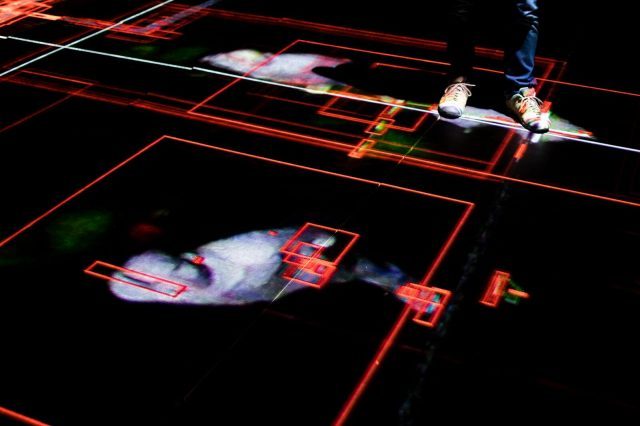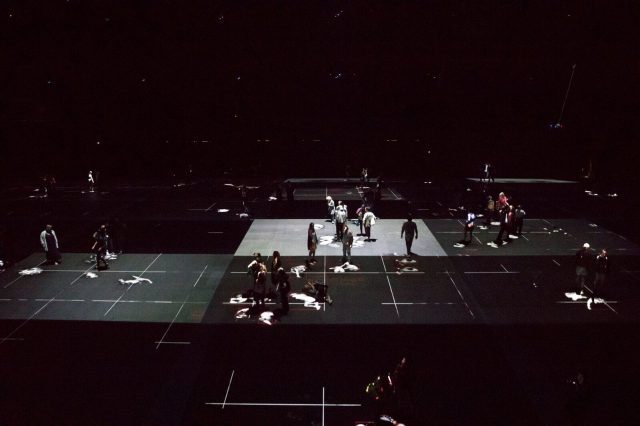
Visitors’ paths are closely followed in immersive “Hansel & Gretel” installation at Park Avenue Armory (photo by James Ewing)
Park Avenue Armory
643 Park Ave. at 67th St.
Tuesday – Sunday through August 6, $15 (free with IDNYC card)
212-933-5812
www.armoryonpark.org
Upon walking into the Park Avenue Armory through a small back entrance on Lexington Ave. and Sixty-Sixth St. to see the immersive, interactive exhibition “Hansel & Gretel,” visitors face the following statement on a wall in front of them: “What would be a suspicious text?” The exhibit, the latest collaboration between Chinese dissident artist and activist Ai Weiwei and Swiss Pritzker Prize-winning architects Jacques Herzog and Pierre de Meuron, is all about suspicion. It is both a fun and revealing exploration of surveillance in the twenty-first century, best experienced with no advance knowledge, so I strongly advise you to stop reading now and pick up where you left off after you have made your way through the two parts of the eye-opening show. After walking down an eerie hallway, you emerge into the Wade Thompson Drill Hall, totally dark aside from occasional pockets of light — fewer if you are lucky enough to be there when there are not many other people, more if you are there when it’s busy. You are unsure of every step, as the material under your feet feels unsafe and there appear to be rises and dips, so your physical safety is threatened by the unknown. Soon you reach a series of large rectangular grids on which are cast white and red electronic lines that trace your path, along with distorted photographs of your head and body taken by infrared cameras located across the ceiling. Occasionally a drone whirs by overhead, the propellers sending down a burst of wind while the drones take yet more pictures of you. “Here the breadcrumbs of the famous Hansel and Gretel fairy tale are not eaten by birds but rather digital crumbs are gathered and stored, reminiscent of Ray Bradbury’s poignant 1953 science-fiction, Fahrenheit 451, where an omniscient state surveils its citizens from the skies,” curators Tom Eccles and Hans-Ulrich Obrist write in the exhibition program.

Latest collaboration by Ai Weiwei, Jacques Herzog, and Pierre de Meuron reveals much about privacy and surveillance in the twenty-first century (photo by James Ewing)
The installation then leads you outside, where you walk around the block to enter through the main doors on Park Avenue and encounter a series of tables with available laptops in the hallways of the Head House, lined with blurry large-scale photographs of the people around you. The computers offer an illuminating look into the history of surveillance and frightening military drone statistics while also providing background information on the creation of the project, including the facial recognition technology by Adam Harvey, the floor projections by iart, and the drones by PhotoFlight Aerial Media and Easy Aerial. Despite having just been surveiled in the drill hall, you are likely to have the computer take your photo, locate your image in its database, and reveal it on the wall — and you’re even more likely to be happy about your face now joining photos of other exhibition-goers and the portraits of American military heroes that regularly fill the hallway. It’s a brilliant commentary on how blithely we leave our personal trail of crumbs now, inured to constantly sharing our email addresses, phone numbers, image, and other facts about ourselves via social media and online purchasing. “I think we all have a personal experience of being under surveillance, but the character of surveillance is that you only see one side of the story,” Ai, who knows what it’s like to be under 24/7 watch, said at the press opening. Ai, Herzog, and de Meuron, whose fifteen-year collaboration includes the Bird’s Nest Stadium at the 2008 Beijing Olympics and the Serpentine Gallery Pavilion at the London 2012 Festival — Herzog and de Meuron are also overseeing the restoration of the Park Avenue Armory itself — have created an immersive environment that is far from a fairy-tale world and instead a dramatic and engaging public space that highlights just how much we have accepted being tracked constantly. A pair of tiny keyholes in the door at the top of the balcony lets viewers move aside brass disks to secretly observe installation visitors below, a down-to-earth analog reminder of the age-old delight humans take in spying on one another, now magnified by today’s technology into monstrous, inescapable form — with an added soupçon of exhibitionistic enjoyment.